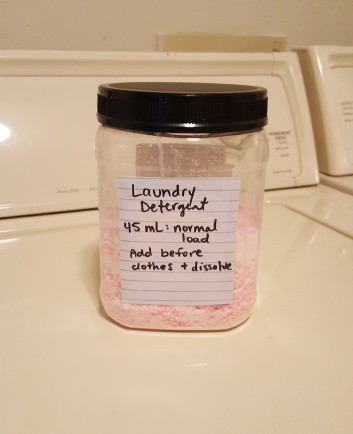I had thought about making homemade laundry detergent for a while. But would it clean my clothes well? How much money would I save?
There are a TON of online articles and blog posts with recipes for homemade laundry detergent. Most use a combination of ingredients such as washing soda, borax, soap, and stain remover or brightener (e.g. OxyClean). There are so many different recipes, it’s hard to know what’s really going to work well.
I found just one blogger who knew the key to resolving my confusion, Ivory Soap at Little House in the Suburbs. Her posts bring to light something important that some DIY-ers may be forgetting: Laundry is just chemistry, people. She helped me understand why these ingredients are in detergent recipes and what mistakes people are making with their recipes.
Mistakes? Like what?
Well, for one, making liquid detergent from a powdered detergent recipe. I’ve personally always bought liquid detergents until this point in my life. Liquid just seemed easier; I didn’t have to make sure it dissolved. The problem, however, is those pesky acids and bases. Acids and bases dissociate in water. That means they break up into little charged ions and hook up with water. Over time, the chemicals can lose their potency.
Don’t pre-dissolve your OxyClean in water. You can make a liquid detergent using borax, but you’ll make a stronger detergent overall if you make a powdered detergent using washing soda instead.
Another mistake: redundant ingredients. Some recipes use baking soda and washing soda, but washing soda is basically a more powerful version of baking soda. Washing soda is sodium carbonate, and baking soda is sodium bicarbonate. Washing soda has twice as many sodium atoms per molecule, making it a stronger base (alkali) and about twice as good at cleaning.
Any other tips from Ms. Ivory Soap? Yep. Some laundry detergent recipes are leaving out a couple important chemicals: enzymes to break down stains, and brighteners to trick your eyes into seeing clean clothes. I’m not overly worried about removing stains, but I decided to use Zote soap because it contains optical brighteners that work by fluorescence. Fluorescence is pretty neat, even when it’s used in laundry rather than glow sticks.
There’s more chemistry to be learned about laundry, like how borax breaks down into hydrogen peroxide, but I just learned enough information to make what I wanted.
I’ve been using her recipe, too. I trust people who do their chemistry homework.
I use 12 oz grated Zote soap per 2 cups Arm & Hammer Washing Soda. Grating soap faster than I can by hand is another way my food processor has proved its worth. I add 3 tablespoons of detergent per medium load, sometimes adding 1/2 cup white vinegar in the rinse cycle.


Is it cheaper than buying detergent?
55 oz Arm & Hammer Super Washing Soda: $3.97 (actually $3.22 with Ibotta coupon, but let’s assume no coupon)
14.1 oz Pink Zote Soap $0.97
A recipe using 12 oz of Zote and 2 cups of washing soda costs $3.88.
Cost per load (45 mL): $0.07*
That’s a great deal! Brands like Tide usually sell for at least $0.20 per load. The cheaper brands I usually buy still cost about $0.15 per load, so this homemade recipe is half the cost I’d usually spend on laundry detergent, in exchange for a little preparation work.
*This calculation assumes the density of Zote is 1.06 g/cm³ (calculated from weight on package and measurements of bar dimensions) and density of washing soda is 2.54 g/cm³ (the density of pure sodium carbonate).
Does it clean clothes as well as store bought detergent?
I’ve been using it for a few months, and my clothes are just as clean as when I used commercial liquid detergent. As long as I add the soap while the washer is filling with warm water, I have not had problems with undissolved detergent left on the clothes. I also really like the scent of pink Zote!

Leave a comment